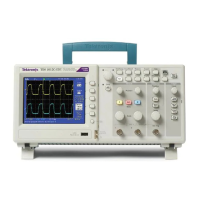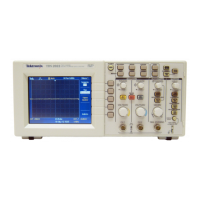Understanding Oscilloscope F unctions
Graticule
This method all
ows you to make a quick, visual estimate. For example, you might
look at a waveform amplitude and determine that it is a little more than 100 mV.
You can take simple measurements by counting the major and minor graticule
divisions involved and multiplying by the scale factor.
Forexample,ifyoucountedfive major vertical graticule divisions between the
minimum and maximum values of a waveform and knew you had a scale factor of
100 mV/
division, then you could calculate your peak-to-peak voltage as follows:
5 divisions x 100 mV/division = 500 mV
Cursor
Cursors
This method allows you to take measurements by moving the cursors, which
always appear in pairs, and reading their numeric values from the d isplay readouts.
There a re two types of cursors: Amplitude and Time.
When you use cursors, be sure to set the Source to the waveform on the display
that you want to measure.
To use cursors, push the Cursor button.
Amplitude Cursors. Amplitude cursors appear as horizontal lines on the display
and measure the vertical parameters. Amplitudes are referenced to the reference
level. For the Math FFT function, these cursors measure magnitude.
Time Cursors. Time cursors appear as vertical lines on the display and measure
both horizontal and vertical parameters. Times are referenced to the trigger point.
For the Math FFT function, these cursors measure frequency.
Time cursors also include a readout of the waveform amplitude at the point the
waveform crosses the cursor.
Automatic
The Measure Me nu ca n take up to five automatic measurements. When you
take automatic measurements, the oscilloscope does all the calculating for you.
Because the measurements use the waveform record points, they are more
accurate than the graticule or cursor measurements.
26 TDS2000C and TDS1000C-EDU Series Oscilloscope User Manual

